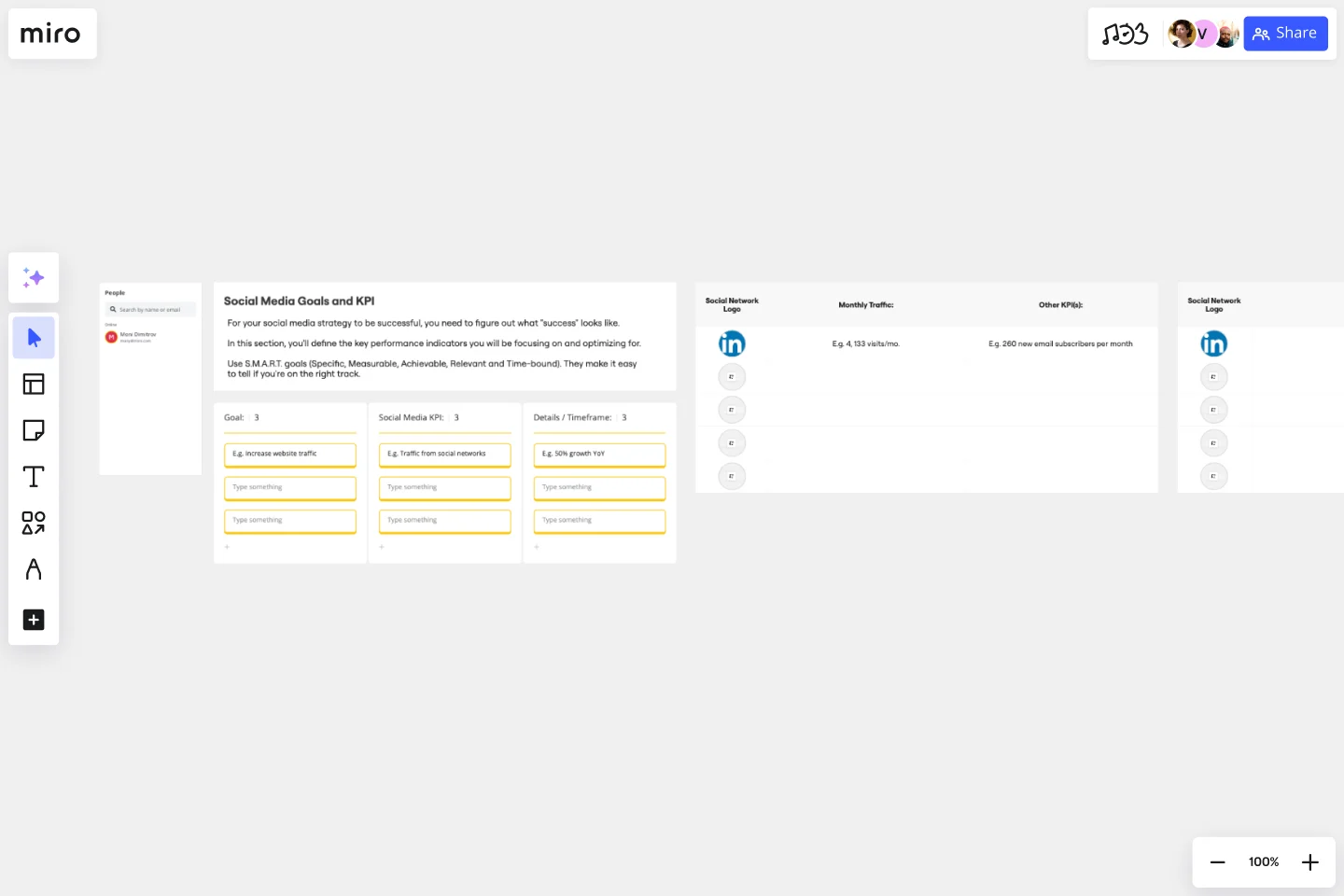Social Media Strategy Template
Easily plan, strategize, and coordinate social media campaigns with our social media strategy template.
About the Social Media Strategy Template
Enhance your social media presence with our social media strategy template. This template is specifically designed to cater to the needs of social media managers, marketers, and teams. It streamlines your planning and execution, providing a strong foundation to improve your social media strategy.
This template has three key areas, ensuring a well-rounded approach to social media management. Let's dive into the elements:
Social media goals and KPIs: Define your objectives and key performance indicators, aligning your team towards standard success metrics.
Top competitors: Analyze and understand your competition, refining your strategy to stand out in the crowded social landscape.
What we will listen to, and how will we respond? Craft a responsive strategy by outlining the type of content you'll monitor and the corresponding engagement plan.
How to use the social media strategy template
Unlock the full potential of our template with these simple steps:
Edit with ease: Customize the template effortlessly by double-clicking sections to make edits, tailoring it to your unique requirements.
Expand the template: Double-click on the table to add more fields and details, ensuring your social media strategy is as detailed as needed.
Add context: Improve your strategy by incorporating artifacts directly onto your Miro board. Embed images, links, or other resources to provide richer context and clarity.
Why should you use the social media strategy template?
Efficiency: Streamline your planning process, saving time and resources.
Consistency: Ensure a consistent approach across campaigns for a unified brand presence.
Collaboration: Foster collaboration among team members by providing a centralized space for strategy discussions.
Clear communication: Clearly articulate goals and objectives, reducing the risk of misunderstandings within your team.
Adaptability: Easily adapt your strategy as needed, responding to the dynamic nature of social media trends.
How can I add more details to the template?
Simply double-click on the table to expand and add additional fields, ensuring your strategy is as detailed as necessary.
Can I include visual elements in the template for better context?
Yes, you can enhance your strategy by incorporating images, links, or any other artifacts directly onto your Miro board.
Is the template suitable for planning campaigns on all social media platforms?
The social media strategy template can be used to plan and coordinate campaigns on many different social media platforms, just adjust the template according to your channel needs.
Get started with this template right now.
Brand Positioning Template
Works best for:
Strategy, Branding, Planning
The Brand Positioning Template is a valuable tool that helps businesses establish a strong market presence. It brings clarity and focus to a brand's identity and messaging by guiding users through a structured process. This ensures all aspects of a brand's positioning are aligned and thoughtfully considered. The Brand Positioning Template helps businesses articulate their unique value proposition, ensuring their messaging resonates effectively with their target audience and stands out.
Floor Plan Template
Works best for:
Operations, Workshops
Maybe you’re planning a big occasion or event. Or maybe you’re arranging seating structures and traffic flows that are more permanent. Either way, creating a floor plan—an overhead scaled diagram of the space—is equal parts functional and fun. This template will let you visualize how people will move about the space and know quickly if the space will do what you need, before you commit time, money, or resources. And you’ll be able to get as detailed as you want—finding the right measurements and dimensions, and adding or removing appliances and furniture.
Media Planning Template
Works best for:
Planning, Strategy, Marketing
The Media Planning Template is a comprehensive tool that helps professionals navigate the complexities of media strategy and event orchestration. This template provides a structured framework that includes event details such as date, location, and description, a systematic countdown to the event, a breakdown of various media types and channels, and key milestones to track week-by-week progress. One of the benefits of using this template is its user-friendly layout, which simplifies the planning process and ensures that every crucial aspect of a media event or campaign is visually represented and easily accessible. This promotes efficiency and helps to ensure that every critical detail is noticed.
Buyer Persona Template
Works best for:
Marketing, Desk Research, User Experience
You have an ideal customer: The group (or few groups) of people who will buy and love your product or service. But to reach that ideal customer, your entire team or company has to align on who that is. Buyer personas give you a simple but creative way to get that done. These semi-fictional representations of your current and potential customers can help you shape your product offering, weed out the “bad apples,” and tailor your marketing strategies for serious success.
Niching Down: Online Course Persona Empathy Map
Works best for:
Market Research, Research & Design
Niching Down Online Course Persona Empathy Map helps you tailor online courses to specific personas. By understanding their needs and motivations, you can design more effective and engaging course content. Perfect for course developers and educators.
Product Positioning Template
Works best for:
Marketing, Product Management, Desk Research
For better or for worse, your company’s chances for success hinge partially on your market. As such, before you start building products and planning strategies, it’s a good idea to conduct a product positioning exercise. A product positioning exercise is designed to situate your company and your offering within a market. The product positioning template guides you to consider key topics such as defining your product and market category, identifying your target segment and competitors, and understanding your key benefits and differentiation.
